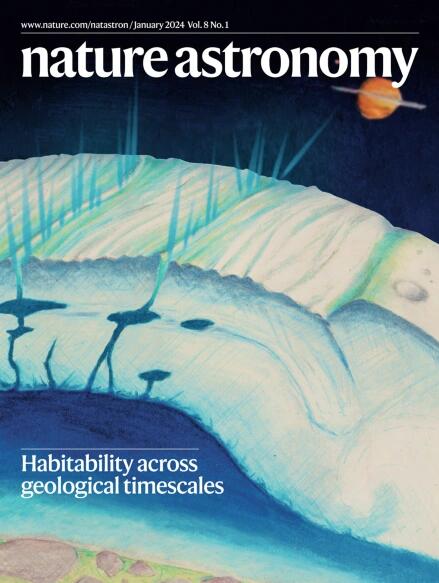非常宽的轨道行星从动态不稳定在恒星诞生星团阶段
IF 14.3
1区 物理与天体物理
Q1 ASTRONOMY & ASTROPHYSICS
引用次数: 0
摘要
在其他恒星周围的偏心轨道上,已经发现了数百个天文单位大小的巨型气体行星。有人提出,甚至太阳也有一颗宽轨道行星,质量是地球的5-10倍,通常被称为第九行星,它影响着遥远的海王星外天体的动力学。然而,这些行星的形成机制仍然不确定。在这里,我们使用数值模拟来表明,非常宽的轨道行星是在行星系统中发生的动态不稳定性的自然副产品,而它们的主星仍然嵌入在出生的恒星群中。一颗行星首先通过其他行星的反复引力散射,以几百个天文单位的距离进入偏心轨道,然后来自附近恒星飞掠的扰动通过将行星与内部系统的相互作用解耦来稳定轨道。在我们的太阳系中,两个可能有利于行星散射的主要事件是天王星和海王星的成长,以及巨行星的不稳定。我们估计,如果其中一个发生在太阳还处于其诞生星团中时,那么产生一颗非常宽轨道行星的可能性为5-10%,如果两者都发生,则增加到40%。在我们模拟的系外行星系统中,捕获效率为1-5%。我们的结果表明,在宽的偏心轨道上,每颗恒星至少有10−3颗行星。本文章由计算机程序翻译,如有差异,请以英文原文为准。


Very-wide-orbit planets from dynamical instabilities during the stellar birth cluster phase
Gas-giant planets have been detected on eccentric orbits several hundreds of astronomical units in size around other stars. It has been proposed that even the Sun hosts a wide-orbit planet of 5–10 Earth masses, often called Planet Nine, which influences the dynamics of distant trans-Neptunian objects. However, the formation mechanism of such planets remains uncertain. Here we use numerical simulations to show that very-wide-orbit planets are a natural by-product of dynamical instabilities that occur in planetary systems while their host stars are still embedded in natal stellar clusters. A planet is first brought to an eccentric orbit with an apoastron of several hundred astronomical units by repeated gravitational scattering by other planets, then perturbations from nearby stellar flybys stabilize the orbit by decoupling the planet from the interaction with the inner system. In our Solar System, the two main events likely conducive to planetary scattering were the growth of Uranus and Neptune, and the giant planets instability. We estimate a 5–10% likelihood of creating a very-wide-orbit planet if either happened while the Sun was still in its birth cluster, increasing to 40% if both were. In our simulated exoplanetary systems, the trapping efficiency is 1–5%. Our results imply that planets on wide, eccentric orbits occur at least 10−3 per star. Giant planets on wide, eccentric orbits—like the putative Planet Nine—may form from dynamical planetary instabilities when stars are embedded in their natal stellar clusters. Simulations suggest a 1–5% chance of such planets forming in exoplanetary systems and up to 40% in the Solar System.
求助全文
通过发布文献求助,成功后即可免费获取论文全文。
去求助
来源期刊

Nature Astronomy
Physics and Astronomy-Astronomy and Astrophysics
CiteScore
19.50
自引率
2.80%
发文量
252
期刊介绍:
Nature Astronomy, the oldest science, has played a significant role in the history of Nature. Throughout the years, pioneering discoveries such as the first quasar, exoplanet, and understanding of spiral nebulae have been reported in the journal. With the introduction of Nature Astronomy, the field now receives expanded coverage, welcoming research in astronomy, astrophysics, and planetary science. The primary objective is to encourage closer collaboration among researchers in these related areas.
Similar to other journals under the Nature brand, Nature Astronomy boasts a devoted team of professional editors, ensuring fairness and rigorous peer-review processes. The journal maintains high standards in copy-editing and production, ensuring timely publication and editorial independence.
In addition to original research, Nature Astronomy publishes a wide range of content, including Comments, Reviews, News and Views, Features, and Correspondence. This diverse collection covers various disciplines within astronomy and includes contributions from a diverse range of voices.
 求助内容:
求助内容: 应助结果提醒方式:
应助结果提醒方式:


